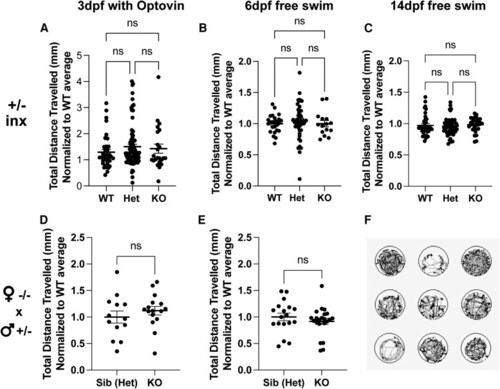
Loss of mtmr5 does not affect motor functions. (A) Embryos generated from a mtmr5-heterozygous (+/−) in-cross (inx) were subjected to Optovin treatment at 3 days post-fertilization (dpf) followed by the quantification of the total distance travelled (mm) by each embryo via ZebraBox. There was no apparent difference in swim performance between wild-type (WT) n = 36, heterozygous (Het) n = 77, and knockouts (KO) n = 23. (B and C) Embryos resulting from a heterozygous in-cross were subjected to a free swim assay (no Optovin treatment) at (B) 6 dpf (WT n = 25, Het n = 47, KO n = 15) and (C) 14 dpf (WT n = 35, Het n = 30, KO n = 15). There were no observed differences in swim performance between the three genotypes at both developmental stages. (D and E) Embryos resulting from a homozygous knockout female crossed with a heterozygous male were subjected to swim assays at (D) 3 dpf (with Optovin treatment; Sib (Het) n = 13, KO n = 16), and at (E) 6 dpf (free swimming assay) (Sib (Het) n = 17, KO n = 22), and again, at both developmental time points, there were no differences in swimming performance between the genotypes. (F) A representative image of the swim trace tracking used by the ZebraBox program to quantify the total distance travelled (mm) for each embryo per well. All statistical analyses include at least three independent experiments. Each dot on the graphs represents one zebrafish, at least n = 4 zebrafish were used per group per experiment. Quantitative data are mean±SEM, normalized to the average of WT and presented as ratios. One-way ANOVA analysis was performed for all heterozygous in-cross experiments and an unpaired two-tailed Student’s t-test was used for the homozygous female × heterozygous male experiment; ns = not significant, P > 0.05.
|

